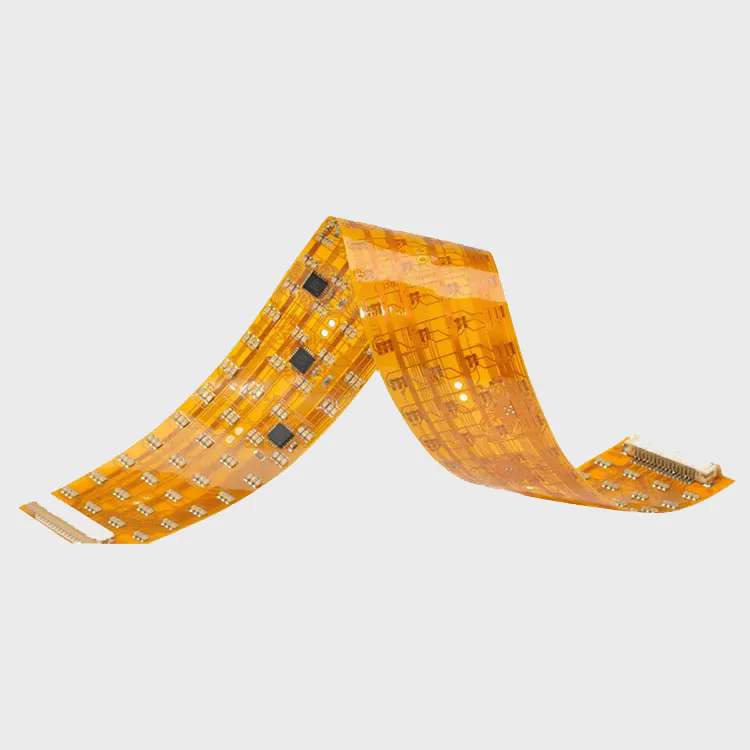Flexible PCBs: The Future of Circuit Design and Application
2024-09-19
In the ever-evolving world of electronics, flexibility and adaptability are key. Enter the realm of Flexible Printed Circuit Boards (Flexible PCBs)—a technological marvel that is reshaping the way electronic devices are designed and used. Flexible PCBs offer a range of benefits that make them indispensable in modern electronics, from their versatility in design to their ability to save space and reduce weight. In this blog, we’ll explore what flexible PCBs are, their advantages, applications, and the future of this innovative technology.
What is a Flexible PCB?
A Flexible Printed Circuit Board (Flexible PCB) is a type of circuit board that is designed to be flexible and bendable. Unlike traditional rigid PCBs, which are made from solid materials like fiberglass, flexible PCBs are constructed from flexible materials such as polyimide or polyester. These materials allow the circuit board to be bent, twisted, and folded without compromising its functionality.
Flexible PCBs are often used in conjunction with a printed circuit layer, which includes conductive pathways (traces) that connect electronic components. The flexibility of the PCB comes from its substrate, which can be shaped and conformed to fit into various spaces and applications.
Advantages of Flexible PCBs
1. Design Flexibility
One of the most significant advantages of flexible PCBs is their ability to conform to complex shapes and structures. This design flexibility allows for more compact and intricate electronic assemblies, making it possible to create devices with unique form factors and layouts. This is particularly valuable in industries where space is limited, such as in consumer electronics and medical devices.
2. Space and Weight Savings
Flexible PCBs can reduce the size and weight of electronic devices by eliminating the need for additional connectors and cables. Their thin and lightweight nature allows them to be integrated directly into the device’s structure, leading to more compact and lightweight designs. This is crucial in applications where every gram and millimeter counts, such as in aerospace and wearable technology.
3. Enhanced Durability
Flexible PCBs are designed to withstand mechanical stress and vibrations better than their rigid counterparts. The flexible materials used in their construction can absorb shocks and impacts, making them ideal for applications where the circuit board may be subjected to movement or bending. This durability enhances the overall reliability and lifespan of the electronic device.
4. Reduced Assembly Costs
The integration of flexible PCBs into electronic devices can streamline the assembly process by reducing the need for additional wiring and connectors. This can lead to lower manufacturing costs and faster production times. Additionally, flexible PCBs can simplify the overall design and reduce the number of components required, further contributing to cost savings.
5. Improved Heat Dissipation
Flexible PCBs can be designed to better manage heat dissipation compared to rigid PCBs. The flexible substrate can help spread heat more evenly across the board, reducing the risk of localized overheating and improving the overall thermal performance of the device.
Applications of Flexible PCBs
1. Consumer Electronics
Flexible PCBs are widely used in consumer electronics such as smartphones, tablets, and wearables. Their ability to fit into compact spaces and conform to the device’s shape makes them ideal for integrating complex electronic components in small, portable devices.
2. Medical Devices
In the medical field, flexible PCBs are used in various diagnostic and monitoring devices, including wearable health monitors and flexible sensors. The flexibility of the PCBs allows them to be integrated into medical devices that require conformal and lightweight designs.
3. Aerospace and Automotive
The aerospace and automotive industries benefit from the durability and space-saving properties of flexible PCBs. They are used in applications such as avionics systems, control panels, and automotive electronics, where reliable performance and compact designs are essential.
4. Wearable Technology
Wearable technology, such as fitness trackers and smartwatches, relies heavily on flexible PCBs. The flexibility of these PCBs allows them to be seamlessly integrated into wearable devices, providing the necessary electronic functionality without compromising comfort or design.
5. Industrial Equipment
Flexible PCBs are also used in industrial equipment and machinery, where their ability to withstand mechanical stress and vibrations is crucial. They can be found in sensors, control systems, and other industrial applications that require robust and flexible electronic solutions.
The Future of Flexible PCBs
As technology continues to advance, the role of flexible PCBs is expected to expand. Innovations in materials and manufacturing processes are likely to lead to even more flexible and durable PCBs, opening up new possibilities for electronic design and application. The integration of flexible PCBs with emerging technologies such as flexible displays and advanced sensors will further enhance their versatility and functionality.
Conclusion
Flexible PCBs are transforming the landscape of electronics by offering unprecedented design flexibility, space savings, and durability. Their ability to conform to complex shapes and withstand mechanical stress makes them a valuable component in a wide range of applications, from consumer electronics to medical devices and beyond. As technology progresses, flexible PCBs will continue to play a crucial role in driving innovation and shaping the future of electronic design. Whether you’re developing the next generation of wearable tech or designing compact consumer gadgets, flexible PCBs are a technology worth embracing.



